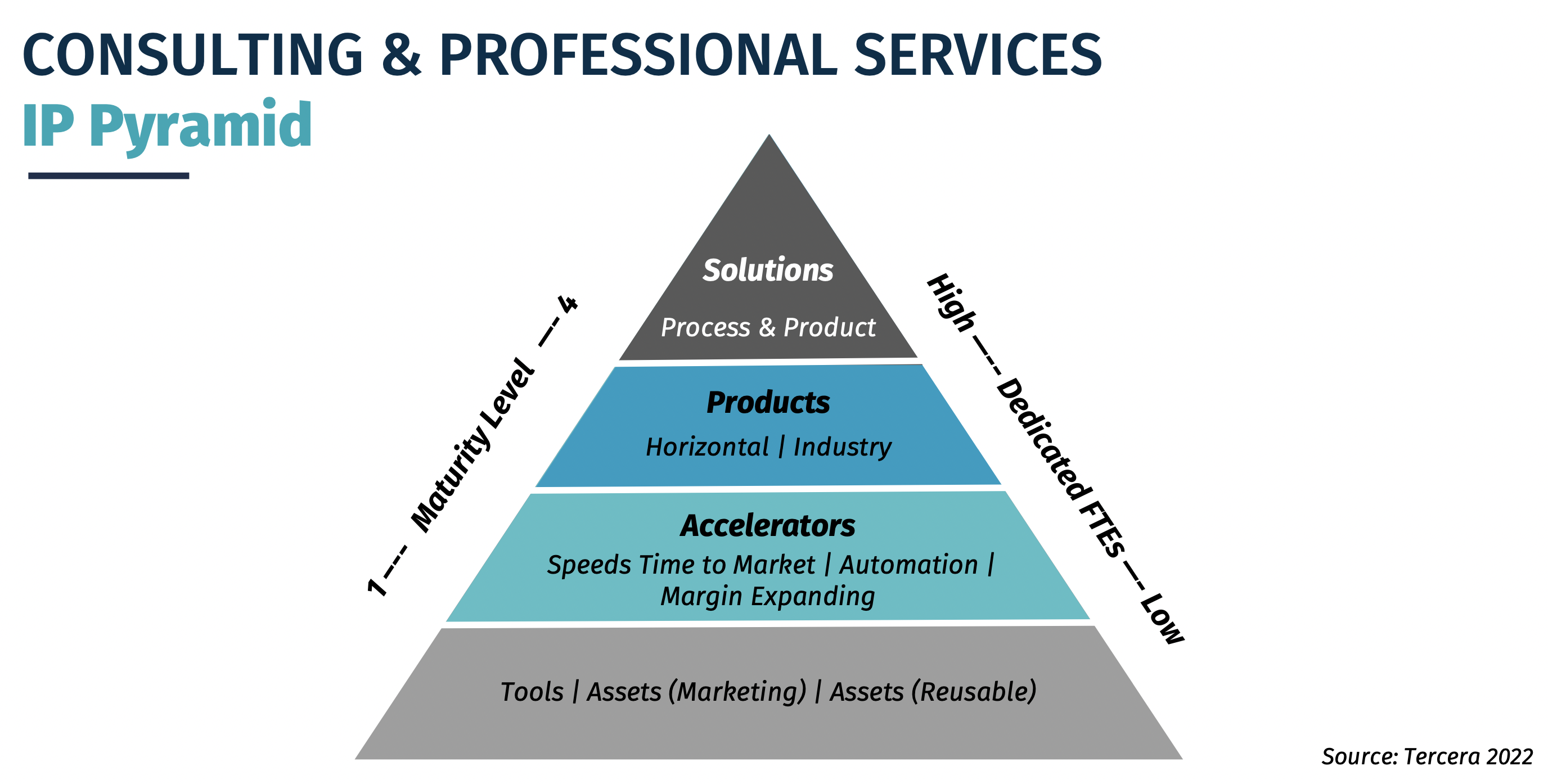Technology consultancies and systems integrators have been proclaiming the prowess of their Intellectual Property (or IP) for decades. In the pre-cloud era, that IP often took the shape of a giant binder filled with strategy decisions destined to sit on a shelf collecting dust. Today, IP has taken on greater importance for services firms, moving from a ‘nice to have’ to a ‘must-have’.
Why is that? Because in the cloud’s third wave, where so much of the IT stack is delivered as-a-service, IP is expected. Customers want proven, packaged expertise to help them move faster and save money. Software vendors want their consulting partners to offer solutions that can extend the value of their platforms and drive customers to their marketplaces. And investors want the margins and multiples that come with software and recurring revenue.
However, all IP isn’t created equal.
The Value of Services IP — And Why Everyone Claims to Have it
Most consultancies are brought in to solve bespoke customer problems, which can make it tough to stand out from the competition. How many times can a customer hear: “we’ve got the smartest people!” or “we know this [fill in the blank] space better than anyone else!” before they start to tune out.
IP can help illustrate a firm’s expertise and differentiate in a more substantive way. If a consultancy has an asset (whatever form that might take) that’s been used to help other customers tackle a similar challenge, that’s a powerful message. It’s powerful to prospects and to the vendors who depend on consulting partners to keep customers happy.
The beauty of IP is that it’s predictable. While people and their outputs vary, IP is a bedrock of consistency and (hopefully) quality. That predictability can help teams move faster and reduce the risk of doing something for the first time.
The beauty of IP is that it’s predictable.
IP can also increase scale and automation, which means faster results for customers, and better margins and more profits for the service provider. Here’s an example: Say a customer needs to automate a specific business or industry workflow. A consultancy can throw eight people at the problem and bill the customer for every hour those people work, which is a traditional time & materials billing model. However, if that consultancy has re-usable IP that can solve 80% of the problem, it might be able to provide the same service with just four employees while still charging the full price. Or it can lower the price to win a deal. In an economic environment where cost and quick time-to-value matter, IP can be a clear competitive advantage.
In an economic environment where cost and quick time-to-value matter, IP can be a clear competitive advantage.
Truly productized IP can also add a level of customer stickiness and a consistent revenue stream, especially if it’s delivered as a monthly or annual subscription. This kind of predictability helps to reduce the revenue swings that often happen with project-oriented businesses, and it delivers better margins than time and materials billing. This is why product companies typically receive higher valuations than services companies.
However, products and services companies have very different DNA. They’re optimized for different go-to-market motions. Processes, pricing, resourcing and support models are also different, as are customer expectations. When a customer buys a product, they expect a certain level of ongoing support over a long period of time. That doesn’t always jive with the project or program mentality in most services companies, where products are often seen as a means to sell more services. All of this makes it very difficult to be exceptional at both products and services. It’s like running two different companies, and while it’s not impossible to succeed with both, it is rare.
It’s very difficult to be exceptional at both products and services. It’s like running two different companies, and while it’s not impossible to succeed with both, it is rare.
The IP Maturity Pyramid
When we evaluate IP within a services firm, we think of it as a pyramid. The higher up you go on the pyramid, the more mature and stand-alone the IP should be, which also translates to higher levels of resourcing and investment.

At the bottom is the least sophisticated IP: off-the-shelf tools or reusable assets that are more valuable for sales and marketing than they are for delivery. Examples of this include reference architectures, design libraries or even small snippets of code. These assets play a critical role in competitive differentiation, but they aren’t necessarily designed to drive a differentiated level of delivery efficiency or productivity.
One step up are accelerators, which range from custom-built tools to pre-built integrations and connectors that automate parts of development or product implementations. A good example of this is BeyondID’s EPIC and Okta connector that enables healthcare organizations to automate provisioning for providers and patients. Or Zennify’s pre-built connector for Salesforce Financial Service Cloud and Jack Henry Symitar, a common core banking system for credit unions. Both of these accelerators are a huge value add to customers, but are not built to be standalone products.
Further up on the pyramid are standalone, fully-supported products that can be used independent of using a specific service provider. A number of the big GSI and digital engineering firms have set up incubators, sometimes in collaboration with their tech partners, to evolve internal IP into products that they market independently. Globant’s MagnifAI, which uses AI to simplify quality assurance testing for complex visual test scenarios, is a great example of this.
Finally, at the very top of the pyramid, are productized horizontal and vertical solutions that combine standalone technology with the surrounding advisory, training and management services. IBM’s Watson solutions are a good example of this, with Watson solutions targeting everything from advertising and human resources to healthcare and risk management.
You’ll notice a trend with those top two IP layers of the pyramid – it’s the large, global services firms getting into truly productized IP in a meaningful way. It’s not usually the small or mid-size firms. That’s because products cost money to develop, and they take dedicated resources and budget to support, maintain and evolve.
4 ways to up your IP game
So many firms we meet with have product ambitions, which can contribute value in lots of ways, but don’t jump into the product game blindly. It’s not easy and the market is littered with services firms claiming to be product companies – and doing neither well.
The market is littered with services firms claiming to be product companies – and doing neither well.
Here are a few ways to increase your IP maturity in a more methodical way:
1) Design and document your IP strategy
Start with your North Star. Are you a services firm that invests in productized IP, or a product company that offers services? You can do both, but you should optimize for one.
Think about how IP fits into your overall business strategy. Is it primarily a way to stand out in the sales cycle? Are you looking to use it to expand project margins? Or are you looking to generate seven figures of product revenue from it? If the latter, you’ll need to budget and invest accordingly.
2) Define what your IP is and who owns it
What are the actual assets, and who is responsible for developing it or driving usage of the IP?
If the assets are used primarily for sales and marketing, you may not need a dedicated owner. When we first started getting into IP at Appirio, we designated one of our consultants as our IP librarian. It eventually turned into a full time role but it wasn’t at the beginning.
Who takes on the role depends on where in the pyramid the IP sits. As you climb the pyramid, you’ll need a more senior product leader (and potentially team) that has products in their DNA. Someone who can design, develop and evolve the product, and just as importantly bring it to market.
3) Understand how IP fits into your delivery methodology or sales motion
If the IP is meant to accelerate and automate delivery, how do your consultants find, use and contribute to your IP portfolio?
If the IP is being jointly developed with a customer or partner, who owns the IP? How will licensing and support work over time? How will you collectively bring it to market?
If the IP is a critical part of your sales motion, how much sales or partner enablement is needed? Who is your ideal customer for this, and what assets and campaigns will drive awareness that this asset exists?
4) Educate and incentive your teams
IP that no one knows about or that sits in a code repository is a waste of time and money. How do you motivate and reward your consultants for using the IP in customer engagements?
If a consultant is measured and compensated based solely on utilization, they may choose to build something from scratch. However, if there’s an incentive to use accelerators or expand on existing assets, that may counterbalance that urge to reinvent the wheel.
Orium is an example of a tech-enabled services firm that’s been very methodical about this. Orium’s Composable.com Accelerator offers reusable front-end UI components and pre-integrations across 32 different composable commerce technologies. Developed over the last two years, it’s become a strategic part of the company’s sales and partner go-to-market motion, and it’s deeply integrated into the firm’s delivery methodology. Today, Orium’s Accelerators are used across 80% of its clients.
5) Measure the success of your strategy
Measure what matters. If you’re investing time and money into your IP, make sure you know why you’re doing it and whether it’s having the desired impact. Here are a few common metrics:
- Are your project margins improving?
- What percentage of your customers are using your IP?
- What percentage of your consultants are using the IP?
- Is customer retention or satisfaction better if IP has been used?
- What is your annual recurring revenue (ARR) for products?
At the end of the day, IP is an asset just like any other. However, because it lacks the inherent definition of physical assets, it’s up to you to define it, package it and put it to use. By carefully applying these strategies, you’ll be able to take your IP to the next level. And—if done correctly—you’ll see a substantial return on all that investment.


